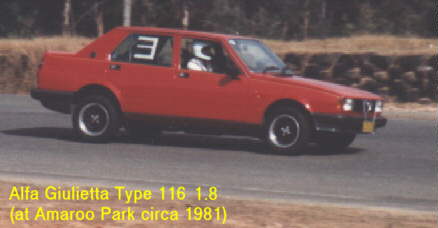An Unsettling and Disturbing Guide to Handling, Modifying and Enjoying Your Car...

Index
Get a life! Or one person's diatribe on staying alive. Skippable, if you must.
Handling 101 - What's handling good for?
Handling 102 - Let's get technical about handling
Handling 103 - Adjusting your car's handling characteristics
Tyre pressures matter
Camber plays a part
Sometimes you must Toe the line!
Caster look over 'ere, mate!
Having a Polar Moment
Roll Over Beethoven
Oversteer
Understeer
Weight transfer explained
Shuffle off this mortal Coil
Tyres and Wheels can do more than just look good
Pitching a fast ball
Other stuff people often don't understand
Heel and Toe
Double declutch
Wheel offset
Rollbars
CVT - Constantly variable transmission
Twin camshaft motors
GTV - Grand Touring Veloce
GTi - Grand Touring Injection
GTam - Grand Touring America or maybe Allegerita Modificato
RS - Rally Sport or Renn Sport
GTO - Grand Touring Omologato
 Rock and Roll
Rock and Roll
Can't talk about oversteer without discussing roll. Well yeah, cars roll along the road, but they also rock and roll from side to side. So what's about this roll business? Firstly let's talk about roll axis. If you took a centre point as far aft as you can go on your car's rear suspension, perhaps halfway along your Panhard rod if you have one (Opel Kadett/Holden Gemini and Alfa Romeo Alfasud are examples) and called that "a". Or if you have a Watts linkage like on an Alfetta then that would be the rearmost point and the pivot point is then the "a". Or if you have a tube or u-beam between your rear wheels like many front-drive cars, just pick dead centre on that as your "a". Then look forward at the control arms or other wheel-controlling suspension pieces that run forwards from the wheel hub and angle inwards towards a fixing point on the car body. Draw a line from each rear wheel along that control arm and extend it until both lines intersect. That's "b". It could be higher, lower or on the same plane as "a".
From a to b is your roll axis. Your car's bodywork will tend to roll around this axis as it corners. If your roll axis falls towards the front of the car then that's an understeering roll axis. Which is to say that the front of the car reacts increasingly less to your steering inputs and you simply, in extremis, run out of road. Symptoms include that "straight-ahead" feeling, where you want to turn but the car doesn't, and lots and lots of steering wheel turning, to no great effect. Also known as front tyre scrub, this is a fairly safe handling characteristic and is often preferred over a car that wants to switch ends!
Speaking of switching ends, if the roll axis rises then it is an oversteering roll axis. Can you see the logic here? The car turns, the body rolls and this motion affects the suspension itself, causing the rear of the car to 'steer'. If the forces are all in the same plane, i.e. your roll axis is parallel to the road, then you get a neutral steer effect. Oversteer, just to be complete here, is when the rear wheels want to overtake the fronts when cornering. So the back end has a tendency towards 'stepping out' as you corner. In extremis this results in the rear end breaking away and, if left uncorrected, the car will end up facing in the direction that it came from. That's called spinning the car.Personally, I prefer a generally understeering car that can be tricked into oversteer at times of my choosing. Front drives are good, in that they will understeer under power but, especially the short-wheelbase models, can also be provoked into oversteer by lifting off the throttle (ahhh, weight transfer!).


